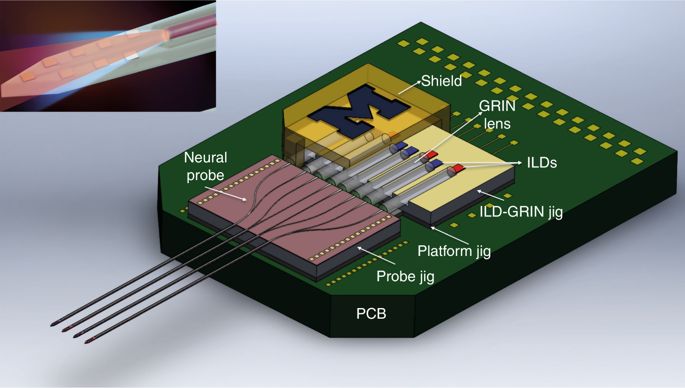Microsystems & Nanoengineering ( IF 7.3 ) Pub Date : 2018-06-04 , DOI: 10.1038/s41378-018-0009-2 Komal Kampasi 1 , Daniel F English 2 , John Seymour 3 , Eran Stark 4 , Sam McKenzie 2 , Mihály Vöröslakos 3 , György Buzsáki 2 , Kensall D Wise 5 , Euisik Yoon 5

|
Optogenetics allows for optical manipulation of neuronal activity and has been increasingly combined with intracellular and extracellular electrophysiological recordings. Genetically-identified classes of neurons are optically manipulated, though the versatility of optogenetics would be increased if independent control of distinct neural populations could be achieved on a sufficient spatial and temporal resolution. We report a scalable multisite optoelectrode design that allows simultaneous optogenetic control of two spatially intermingled neuronal populations in vivo. We describe the design, fabrication, and assembly of low-noise, multisite/multicolor optoelectrodes. Each shank of the four-shank assembly is monolithically integrated with 8 recording sites and a dual-color waveguide mixer with a 7 × 30 μm cross-section, coupled to 405 nm and 635 nm injection laser diodes (ILDs) via gradient-index (GRIN) lenses to meet optical and thermal design requirements. To better understand noise on the recording channels generated during diode-based activation, we developed a lumped-circuit modeling approach for EMI coupling mechanisms and used it to limit artifacts to amplitudes under 100 μV upto an optical output power of 450 μW. We implanted the packaged devices into the CA1 pyramidal layer of awake mice, expressing Channelrhodopsin-2 in pyramidal cells and ChrimsonR in paravalbumin-expressing interneurons, and achieved optical excitation of each cell type using sub-mW illumination. We highlight the potential use of this technology for functional dissection of neural circuits.
中文翻译:

使用低噪声、多柄光电极对神经群体进行双色光遗传学控制
光遗传学允许对神经元活动进行光学操纵,并且越来越多地与细胞内和细胞外电生理记录相结合。基因识别的神经元类别是通过光学操纵的,尽管如果可以在足够的空间和时间分辨率上实现对不同神经群体的独立控制,则光遗传学的多功能性将会增加。我们报告了一种可扩展的多位点光电极设计,可以同时对体内两个空间混合的神经元群体进行光遗传学控制。我们描述了低噪声、多位点/多色光电极的设计、制造和组装。四柄组件的每个柄均与 8 个记录位点和横截面为 7 × 30 μm 的双色波导混频器单片集成,通过梯度折射率 (ILD) 耦合到 405 nm 和 635 nm 注入激光二极管 (ILD) GRIN) 透镜满足光学和热设计要求。为了更好地了解基于二极管的激活过程中记录通道上产生的噪声,我们开发了一种针对 EMI 耦合机制的集总电路建模方法,并用它来将伪影限制在 100 μV 以下,最高光输出功率为 450 μW。我们将封装好的器件植入清醒小鼠的 CA1 锥体层中,在锥体细胞中表达视紫红质通道蛋白 2,在表达副白蛋白的中间神经元中表达 ChrimsonR,并使用亚毫瓦照明实现每种细胞类型的光学激发。我们强调该技术在神经回路功能解剖中的潜在用途。






























 京公网安备 11010802027423号
京公网安备 11010802027423号